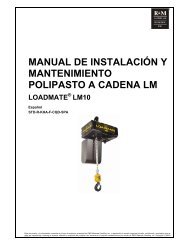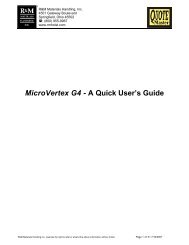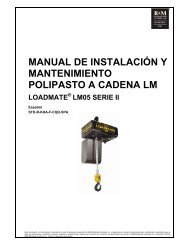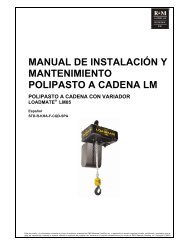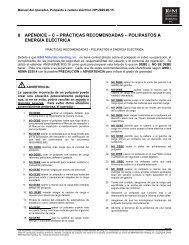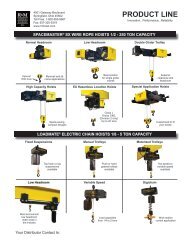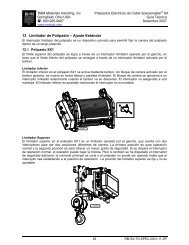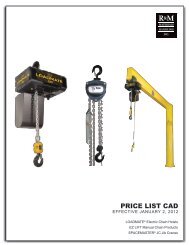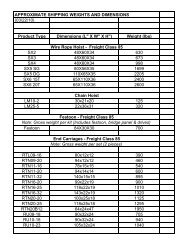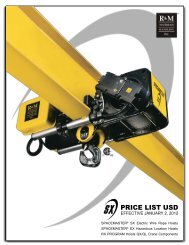Download - R&M Materials Handling equipment
Download - R&M Materials Handling equipment
Download - R&M Materials Handling equipment
Create successful ePaper yourself
Turn your PDF publications into a flip-book with our unique Google optimized e-Paper software.
R&M <strong>Materials</strong> <strong>Handling</strong>, Inc.<br />
4501 Gateway Boulevard<br />
Springfield, Ohio 45502<br />
P.: (937) 328-5100<br />
FAX: (937) 325-5319<br />
7 SPEED SUPERVISION SETTINGS<br />
SSU is a hoist motion speed supervision unit, which reads the pulse frequency from the hoist motor sensor<br />
bearing, encoder or pulse sensor. This pulse frequency is compared with a fixed oscillator frequency and<br />
inverter frequency reference. As a result of frequency comparison, there are three different speed supervision<br />
functions available:<br />
- overspeed supervision (rush control)<br />
- stall supervision<br />
- speed difference supervision<br />
Overspeed supervision (F61) is totally implemented by hardware.<br />
Switches S2-2 and S2-3 divide the full frequency range to four frequency areas.<br />
Selected frequency area is the same for normal and ESR speeds.<br />
The four frequency areas are each divided to lower and upper frequency ranges<br />
Switch S2-1 selects the frequency range at normal speed.<br />
Switch S2-4 selects the frequency range at ESR speed (Extended Speed Range).<br />
The exact tripping frequency level is selected with rotary switches.<br />
Switch S1 sets the tripping level at normal speed (value shown in V4.8.1).<br />
Switch S3 sets the tripping level at ESR speed (value shown in V4.8.2).<br />
Overspeed tripping levels are shown at display as % of the nominal speed. The overspeed setting should be<br />
15-25% above the full speed.<br />
Switches S2-2 and S2-3 select range for overspeed detection level. Range of detection level is the same for<br />
both, normal and ESR (Extended Speed range) use.<br />
Fine adjustment for normal use is done by rotary switch S1 and switch S2-1.<br />
Fine adjustment for ESR use is done by rotary switch S3 and switch S2-4.<br />
Overspeed detection levels are shown at display panel as % of nominal speed. Overspeed setting should be<br />
15-25% above the full speed.<br />
Adjusted overspeed detection level for normal use is shown in parameter V4.8.1.<br />
Adjusted overspeed detection level for ESR use is shown in parameter V4.8.2.<br />
Speed difference supervision (F62) compares the motor actual speed (= pulse frequency) with Drive<br />
frequency reference. In practice this means that the motor slip is measured and if that exceeds a limit,<br />
supervision stops the motion.<br />
Stall supervision (F63) stops the motion if there are no pulses coming from the sensor when the brake is<br />
open (K7 energised).<br />
SSU relay test (F64): SSU Relay is tested in every power up. Driving is prevented if fault has been detected.<br />
SSU Watchdog fault (F65): Communication between SSU board and control board is tested once in 50ms.<br />
Fault will be detected if there is communication error. When a fault is detected the drive is stopped.<br />
SSU Overspeed Limit (F66): maximum setting of overspeed limit is 1.4×maximum speed of direction S2.<br />
Fault will be detected if overspeed limit is set over that value. When a fault is detected the drive is prevented.<br />
43/79<br />
This document and the information contained herein, is the exclusive property of R&M <strong>Materials</strong> <strong>Handling</strong> Inc. and represents a non-public, confidential and proprietary<br />
trade secret that may not be reproduced, disclosed to third parties, altered or otherwise employed in any manner whatsoever without the express written consent of R&M<br />
<strong>Materials</strong> <strong>Handling</strong> Inc. Copyright © (2005) R&M <strong>Materials</strong> <strong>Handling</strong> Inc. All rights reserved.



